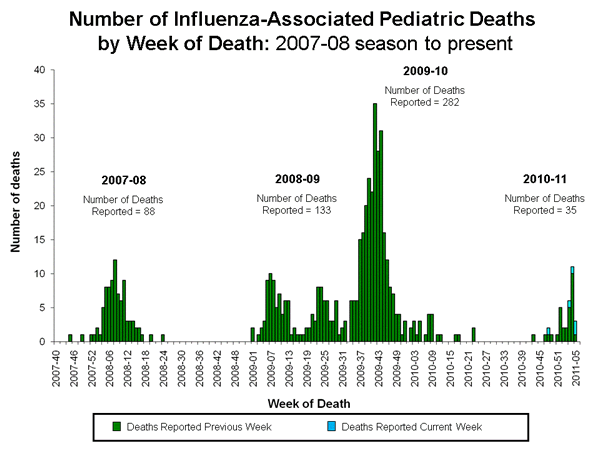

Paradigm Shift Intervention Monitoring
 twitter
twitter

Commentary
US
Pneumonia and Influenza Death Rate Raises Concerns
Recombinomics
Commentary 19:29
February 18, 2011
The above comments from the CDC's week 6 FluView indicate that H1N1 is now causing the majority of pediatric deaths in the United States. These data compliment the Pneumonia and Influenza death rate, which has spiked to 8.9%, which is graphically represented below. The graph displays this data historically, and demonstrates its relations to the five year high of 9.1% recorded in week 11 of 2008. As seen in the graph, there is no indication that the week 6 data represents the peak for this season. The H1N1 levels are clearly rising raising concerns that the death rate will continue to rise.

The toll on pediatric cases is demonstrated in the graph below. There is a significant delay in the reporting of these cases. One of the five cases reported in week 6 is from 2010 (and it is not clear if the earlier death represents the influenza B cases, which was more widespread earlier in the season). Currently week 5 has the highest number of deaths this season, but delayed reporting could lead to numbers that are higher than any prior week displayed, other than the H1N1 cases in the fall of 2009.

These data raise concerns that the number of deaths will markedly increase in upcoming weeks, based on the similarity between the US H1N1 sequences and those reported for the UK. The H1N1 outbreak in the UK peaked earlier, but it severely tested the UK's ability to deliver health care, as ICU beds filled up and ECMO demand exceeded capacity.
As seen in the graphs, there was a significant impact last season when H1N1 dominated. The large number of H1N1 cases this season signals immunological escape, as was seen in the UK. This escape is also supported by the emergence of clades with S188T and S186P as seen in the UK and US as well as most reporting countries in the northern hemisphere. Today WHO issued an H1N1 warning, due in part to the number of severe and fatal cases in the UK this season, as well as the similarity in sequences in the H1N1 isolates. The recent vaccine data from the UK increased concerns, since vaccination did not prevent H1N1 infections in approximately 50% of the cases.
The vaccine failures raise questions about the use of the unreliable antigen characterization data to select vaccine targets, which led to the WHO recommendation to continue to use California/7/2009 for the H1N1 target this season in the northern hemisphere, as well as the 2011 season in the southern hemisphere and the 2011/2012 season in the northern hemisphere.
The reliance on this insensitive assay which generates intra- and inter-lab variations, as well as data that are at odds with extensive sequence and clinical data (as described here and discussed here) continue to be hazardous to the world’s health.
Media link
Recombinomics
Presentations
Recombinomics
Publications
Recombinomics
Paper
at Nature Precedings